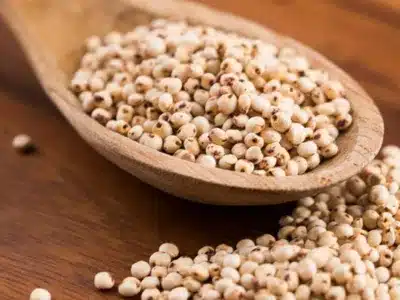Blog
Detailing sustainable farming practices for sorghum cultivation?

I. Introduction
A. Significance of Sustainable Farming B. Growing Interest in Sorghum Cultivation C. Overview of Sustainable Farming Practices
II. Benefits of Sorghum Cultivation
A. Nutritional and Economic Value B. Environmental Impact
III. Selecting Sustainable Sorghum Varieties
A. Adaptability to Local Climates B. Pest and Disease Resistance
IV. Crop Rotation and Diversification
A. Enhancing Soil Health B. Preventing Pest and Disease Outbreaks
V. Water Conservation Strategies
A. Efficient Irrigation Techniques B. Rainwater Harvesting Practices
VI. Organic and Natural Farming Approaches
A. Reduced Chemical Usage B. Promoting Biodiversity
VII. Conservation Tillage Methods
A. Minimal Soil Disturbance B. Weed Control in Sustainable Ways
VIII. Integrated Pest Management
A. Natural Predators and Beneficial Insects B. Minimizing Harmful Pesticide Use
IX. Soil Enrichment Techniques
A. Cover Cropping for Nutrient Retention B. Composting and Organic Matter Addition
X. Community Engagement and Empowerment
A. Collaborative Farming Initiatives B. Knowledge Sharing for Sustainable Practices
XI. Monitoring and Precision Agriculture
A. Technology Integration in Farming B. Data-Driven Decision Making
XII. Economic Viability of Sustainable Sorghum Farming
A. Market Demand for Sustainable Products B. Economic Benefits for Farmers
XIII. Challenges and Solutions
A. Addressing Sustainability Challenges B. Innovative Solutions in Sorghum Farming
XIV. Government and NGO Support
A. Initiatives Promoting Sustainable Practices B. Funding and Training Opportunities
XV. Success Stories in Sustainable Sorghum Farming
A. Showcasing Farmers’ Achievements B. Inspiring Others to Adopt Sustainable Practices
XVI. Conclusion
A. Recap of Sustainable Farming Practices B. Encouraging a Shift Towards Sustainable Sorghum Cultivation
Detailing Sustainable Farming Practices for Sorghum Cultivation
Sorghum cultivation is not just about yields; it’s about creating a sustainable and harmonious relationship with the environment. In this comprehensive guide, we delve into the world of sustainable farming practices for sorghum, exploring methods that not only optimize crop production but also foster ecological balance. From selecting the right sorghum varieties to embracing organic farming and community engagement, discover how sustainable practices are shaping the future of sorghum cultivation.
I. Introduction
A. Significance of Sustainable Farming
Sustainable farming is more than a buzzword—it’s a necessity. We’ll explore why adopting sustainable practices is crucial for the longevity of agriculture.
B. Growing Interest in Sorghum Cultivation
Highlighting the increasing interest in sorghum cultivation and the need to align it with sustainable practices.
C. Overview of Sustainable Farming Practices
A brief overview of the sustainable farming practices that will be detailed in the article.
II. Benefits of Sorghum Cultivation
A. Nutritional and Economic Value
Discussing the nutritional benefits of sorghum and its economic value for farmers, emphasizing the importance of sustainable cultivation.
B. Environmental Impact
Exploring how sorghum cultivation can positively impact the environment through sustainable practices.
III. Selecting Sustainable Sorghum Varieties
A. Adaptability to Local Climates
Detailing how selecting sorghum varieties adapted to local climates promotes sustainability and resilience.
B. Pest and Disease Resistance
Highlighting the importance of choosing sorghum varieties with natural resistance to pests and diseases.
IV. Crop Rotation and Diversification
A. Enhancing Soil Health
Explaining the benefits of crop rotation in maintaining soil fertility and health.
B. Preventing Pest and Disease Outbreaks
Discussing how diversifying crops can naturally reduce the risk of pest and disease outbreaks.
V. Water Conservation Strategies
A. Efficient Irrigation Techniques
Exploring water-efficient irrigation methods for sorghum cultivation.
B. Rainwater Harvesting Practices
Detailing the importance of rainwater harvesting in sustainable water management.
VI. Organic and Natural Farming Approaches
A. Reduced Chemical Usage
Discussing the shift towards organic farming and minimizing the use of synthetic chemicals.
B. Promoting Biodiversity
Exploring how embracing natural farming methods contributes to biodiversity on the farm.
VII. Conservation Tillage Methods
A. Minimal Soil Disturbance
Highlighting the advantages of conservation tillage in maintaining soil structure.
B. Weed Control in Sustainable Ways
Discussing sustainable weed control methods without relying heavily on herbicides.
VIII. Integrated Pest Management
A. Natural Predators and Beneficial Insects
Exploring the concept of using natural predators and beneficial insects to control pests.
B. Minimizing Harmful Pesticide Use
Emphasizing the importance of reducing reliance on harmful pesticides in sorghum farming.
IX. Soil Enrichment Techniques
A. Cover Cropping for Nutrient Retention
Detailing the benefits of cover cropping in retaining nutrients in the soil.
B. Composting and Organic Matter Addition
Discussing how composting and adding organic matter contribute to soil fertility.
X. Community Engagement and Empowerment
A. Collaborative Farming Initiatives
Highlighting the importance of communities coming together for sustainable sorghum cultivation.
B. Knowledge Sharing for Sustainable Practices
Emphasizing the role of knowledge-sharing in empowering farmers to adopt sustainable practices.
XI. Monitoring and Precision Agriculture
A. Technology Integration in Farming
Discussing how technology can be integrated for monitoring and precision agriculture.
B. Data-Driven Decision Making
Exploring the role of data-driven decision-making in optimizing sorghum cultivation.
XII. Economic Viability of Sustainable Sorghum Farming
A. Market Demand for Sustainable Products
Highlighting the increasing market demand for sustainably produced sorghum.
B. Economic Benefits for Farmers
Discussing the economic advantages for farmers practicing sustainable sorghum cultivation.
XIII. Challenges and Solutions
A. Addressing Sustainability Challenges
Detailing common challenges in sustainable sorghum farming and proposing solutions.
B. Innovative Solutions in Sorghum Farming
Highlighting innovative approaches and technologies that address sustainability challenges.
XIV. Government and NGO Support
A. Initiatives Promoting Sustainable Practices
Discussing government and NGO initiatives that support and promote sustainable sorghum farming.
B. Funding and Training Opportunities
Highlighting available funding and training opportunities for farmers adopting sustainable practices.
XV. Success Stories in Sustainable Sorghum Farming
A. Showcasing Farmers’ Achievements
Sharing success stories of farmers who have embraced sustainable sorghum cultivation.
B. Inspiring Others to Adopt Sustainable Practices
Encouraging other farmers to adopt sustainable practices based on these success stories.
XVI. Conclusion
A. Recap of Sustainable Farming Practices
Summarizing the key sustainable farming practices discussed and their importance in sorghum cultivation.
B. Encouraging a Shift Towards Sustainable Sorghum Cultivation
Encouraging readers, farmers, and stakeholders to actively participate in and promote sustainable sorghum cultivation.


